Appraising the Feasibility of 3D Printing Construction in New Zealand Housing
Abstract
:1. Introduction
2. Materials and Methods
2.1. BIM Development and Project Information
2.2. Material Quantity Take-Off
2.3. 3DP Construction Time
2.4. Energy Simulation
2.5. Life Cycle Assessment
3. Results and Discussion
3.1. Overall Environmental Impacts
3.2. Global Warming Potential Results Comparison
- Embrace innovative approaches like Carbon Capture and Storage (CCS) and alternative binder technologies such as geopolymers and LC3 cement.
- Enhance energy efficiency measures.
- Employ alternative fuels in cement kilns.
- Promote higher clinker substitution and the utilisation of Supplementary Cementitious Materials (SCMs) in conventional Portland cement blends.
3.3. Material Impacts in Each Stage
3.4. Summary of Total Material Impacts
3.5. Study Assumptions and Limitations
4. Conclusions
- LCA results substantiated positive environmental characteristics in the 3DP concrete house. The average GWP impacts across the different life cycle stages resulted in the 3DP concrete house’s performance being 20% less carbon emissions compared to the timber house and 25% less than the LSF house. Various research justifies this argument: adopting low-CO2-emitting or high-carbon storage materials like concrete can make a significant difference in the process against climate change [70].
- The energy analysis performance tested by Autodesk GBS software also confirmed the eco-friendly aspects of substituting external timber framing with 3DP concrete walls in enhancing the building’s performance in the New Zealand context. The parameters include a realistic reduction in annual energy, lifecycle costs, electric consumption, and CO2 emissions.
- Timber products are found to release significant carbon during the end-of-life stage, which accounts for 17% (only from timber products) of the total timber house’s carbon emissions. This is mainly due to most timber products going to landfills at the end of their service lives. A study conducted in Auckland found that the majority of construction waste consists of timber (20%), plasterboard (13%), packaging (5%), metal (5%), and miscellaneous materials (45%) [71].
5. Recommendation
Author Contributions
Funding
Data Availability Statement
Acknowledgments
Conflicts of Interest
References
- Auckland Council. Auckland Plan 2050. New Zealand. 2018. Available online: https://www.aucklandcouncil.govt.nz/plans-projects-policies-reports-bylaws/our-plans-strate-gies/auckland-plan/about-the-auckland-plan/docsprintdocuments/auckland-plan-2050-print-document.pdf (accessed on 10 October 2023).
- New Zealand Productivity Commission. Housing Affordability Inquiry. New Zealand. 2012. Available online: https://www.productivity.govt.nz/assets/Documents/9c8ef07dc3/Final-report-Housing-affordability.pdf (accessed on 10 October 2023).
- Soust-Verdaguer, B.; Llatas, C.; Moya, L. Comparative BIM-based Life Cycle Assessment of Uruguayan timber and concrete-masonry single-family houses in design stage. J. Clean. Prod. 2020, 277, 121958. [Google Scholar] [CrossRef]
- UNEP. 2022 Global Status Report for Buildings and Construction: Towards a Zero-Emission, Efficient and Resilient Buildings and Construction Sector. Nairobi. 2022. Available online: https://www.unep.org/resources/publication/2022-global-status-report-buildings-and-construction (accessed on 21 November 2023).
- Vickers, J.; Gamage, G.; Fisher, B.; Nebel, B. Hidden Emissions and Untapped Potential of Buildings for New Zealand’s 2050 Zero Carbon Goal. Thinkstep Ltd.: Wellington, New Zealand, 2019. Available online: https://www.thinkstep-anz.com/resrc/reports/hidden-emissions-and-untapped-potential-of-buildings-for-new-zealands-2050-zero-carbon-goal/ (accessed on 19 November 2023).
- Level. Embodied Energy. BRANZ. 2023. Available online: http://www.level.org.nz/material-use/embodied-energy/ (accessed on 21 November 2023).
- Gibbons, O.P.; Orr, J.J. How to Calculate Embodied Carbon; The Institution of Structural Engineers: London, UK, 2020; Available online: https://www.istructe.org/IStructE/media/Public/Resources/istructe-how-to-calculate-embodied-carbon.pdf (accessed on 21 November 2023).
- Ministry of Business, Innovation & Employment. Whole-of-Life Embodied Carbon Emissions Reduction Framework; MBIE: Wellington, New Zealand, 2020; p. 24. Available online: https://www.mbie.govt.nz/dmsdocument/11794-whole-of-life-embodied-carbon-emissions-reduction-framework (accessed on 22 November 2023).
- Hollberg, A.; Genova, G.; Habert, G. Evaluation of BIM-based LCA results for building design. Autom. Constr. 2019, 109, 102972. [Google Scholar] [CrossRef]
- ISO 14040:2006; Environmental Management—Life Cycle Assessment—Principles and Framework. International Organization for Standardization: Geneva, Switzerland, 2006. Available online: https://www.iso.org/standard/37456.html (accessed on 11 October 2023).
- Anand, C.K.; Amor, B. Recent developments, future challenges and new research directions in LCA of buildings: A critical review. Renew. Sustain. Energy Rev. 2017, 67, 408–416. [Google Scholar] [CrossRef]
- Bahramian, M.; Yetilmezsoy, K. Life cycle assessment of the building industry: An overview of two decades of research (1995–2018). Energy Build. 2020, 219, 109917. [Google Scholar] [CrossRef]
- Ghattas, R.; Gregory, J.; Olivetti, E.; Greene, S. Life Cycle Assessment for Residential Buildings: A Literature Review and Gap Analysis; Concrete Sustainability Hub, Massachusetts Institute of Technology: Cambridge, MA, USA, 2013; pp. 1–21. [Google Scholar] [CrossRef]
- Kylili, A.; Fokaides, P.A. Construction materials for the urban environment: Environmental assessment of life cycle performance. In Handbook of Ecomaterials; Springer International Publishing: Cham, Switzerland, 2019; Volume 3, pp. 2143–2175. [Google Scholar] [CrossRef]
- Hoxha, E.; Habert, G.; Lasvaux, S.; Chevalier, J.; Le Roy, R. Influence of construction material uncertainties on residential building LCA reliability. J. Clean. Prod. 2017, 144, 33–47. [Google Scholar] [CrossRef]
- Bilec, M.M.; Ries, R.J.; Matthews, H.S. Life-Cycle Assessment Modeling of Construction Processes for Buildings. J. Infrastruct. Syst. 2010, 16, 199–205. [Google Scholar] [CrossRef]
- Ortiz, O.; Castells, F.; Sonnemann, G. Sustainability in the construction industry: A review of recent developments based on LCA. Constr. Build. Mater. 2009, 23, 28–39. [Google Scholar] [CrossRef]
- Kivits, R.A.; Furneaux, C. BIM: Enabling Sustainability and Asset Management through Knowledge Management. Sci. World J. 2013, 2013, 1–14. [Google Scholar] [CrossRef] [PubMed]
- Peng, C.; Wu, X. Case Study of Carbon Emissions from a Building’s Life Cycle Based on BIM and Ecotect. Adv. Mater. Sci. Eng. 2015, 2015, 1–15. [Google Scholar] [CrossRef]
- Safari, K.; AzariJafari, H. Challenges and opportunities for integrating BIM and LCA: Methodological choices and framework development. Sustain. Cities Soc. 2021, 67, 102728. [Google Scholar] [CrossRef]
- Soust-Verdaguer, B.; Llatas, C.; García-Martínez, A. Critical review of bim-based LCA method to buildings. Energy Build. 2017, 136, 110–120. [Google Scholar] [CrossRef]
- American Institute of Architects (AIA). Guide, Instructions and Commentary to the 2013 AIA Digital Practice Documents. 2013. Available online: https://zdassets.aiacontracts.org/ctrzdweb02/zdpdfs/digital-practice_guide.pdf (accessed on 30 March 2024).
- BIMinNZ. Appendix C Levels of Development Definition. Digital Guidance Suite: Aotearoa | New Zealand. 2023. Available online: https://static1.squarespace.com/static/57390d2c8259b53089bcf066/t/6584af7ba253c661b2593b09/1703194493883/BIM+Handbook_%28APPENDIX_C%29.v3.pdf (accessed on 30 March 2024).
- AutoDesk. Levels of Development: Enabling Coordination and Collaboration. Available online: https://www.autodesk.com/solutions/bim-levels-of-development (accessed on 30 March 2024).
- BIMForum. Level of Development (LOD) Specification. 2023. Available online: https://bimforum.org/resource/lod-level-of-development-lod-specification/ (accessed on 30 March 2024).
- Shafighfard, T.; Cender, T.A.; Demir, E. Additive manufacturing of compliance optimized variable stiffness composites through short fiber alignment along curvilinear paths. Addit. Manuf. 2020, 37, 101728. [Google Scholar] [CrossRef]
- Apis Cor. Dubai Municipality 3D Printed Building. 2019. Available online: https://www.apis-cor.com/dubai-project (accessed on 28 March 2024).
- CyBe. 3D Studio 2030. 2018. Available online: https://cybe.eu/cases/3d-studio-2030/ (accessed on 17 November 2023).
- Winsun3D. 3D Printing Architecture’s Future. Available online: http://www.winsun3d.com/En/ (accessed on 17 November 2023).
- Loporcaro, G.; Zhao, A. Exploring opportunities and limitations of 3D concrete printing technology in New Zealand. In Proceedings of the Concrete NZ Conference, Dunedin, New Zealand, 10–12 October 2019. [Google Scholar]
- Sakin, M.; Kiroglu, Y.C. 3D Printing of Buildings: Construction of the Sustainable Houses of the Future by BIM. Energy Procedia 2017, 134, 702–711. [Google Scholar] [CrossRef]
- Geneidy, O.; Ismaeel, W.S.E. Investigating the Application of the Three Dimensional Wall Building Technology in Egypt. In Proceedings of the Green Heritage Conference, The British University in Egypt, Cairo, Egypt, 6–8 March 2018; pp. 164–183. [Google Scholar]
- Khoshnevis, B.; Hwang, D.; Yao, K.T.; Yeh, Z. Mega-scale fabrication by Contour Crafting. Int. J. Ind. Syst. Eng. 2006, 1, 301. [Google Scholar] [CrossRef]
- Schuldt, S.J.; Jagoda, J.A.; Hoisington, A.J.; Delorit, J.D. A systematic review and analysis of the viability of 3D-printed construction in remote environments. Autom. Constr. 2021, 125, e103642. [Google Scholar] [CrossRef]
- Fiala, L.; Lin, W.-T.; Hotěk, P.; Cheng, A. Feasibility study of developing cementless blended materials as 3D printable materials. Case Stud. Constr. Mater. 2023, 19, e02675. [Google Scholar] [CrossRef]
- Batikha, M.; Jotangia, R.; Baaj, M.Y.; Mousleh, I. 3D concrete printing for sustainable and economical construction: A comparative study. Autom. Constr. 2021, 134, 104087. [Google Scholar] [CrossRef]
- Masood, R.; Roy, K.; González, V.A.; Lim, J.B.; Nasir, A.R. A supply chain perspective of prefabricated housebuilding diffusion in New Zealand. Eng. Constr. Arch. Manag. 2023; ahead-of-print. [Google Scholar] [CrossRef]
- Masood, R.; Roy, K.; Gonzalez, V.A.; Lim, J.B.; Nasir, A.R. Modeling relational performance of the supply chains for prefabricated housebuilding in New Zealand. Smart Sustain. Built Environ. 2023; ahead-of-print. [Google Scholar] [CrossRef]
- QOROX. TV3—The Project & Newshub Article—QOROX® 3d Printed Houses & More. 2023. Available online: https://qorox.co.nz/news-and-media/tv3-the-project-newshub-article/ (accessed on 28 November 2023).
- Construction Sector Accord. Case Study: QOROX 3D Printing Technology. MBIE. 2022. Available online: https://www.constructionaccord.nz/good-practice/beacon-projects/case-study-qorox-3d-printing/ (accessed on 28 November 2023).
- QOROX. QOROX is a 3D Printing Construction Company to Watch by All3DP.COM. 2022. Available online: https://qorox.co.nz/news-and-media/qorox-is-a-3d-printing-construction-company-to-watch-by-all3dp-com/ (accessed on 15 March 2024).
- QOROX. World 1st Solar Passive Home with 3D Printed Concrete Walls Opens Doors to Public. 2023. Available online: https://qorox.co.nz/news-and-media/world-1st-solar-passive-home-with-3d-printed-concrete-walls-opens-doors-to-public/ (accessed on 15 March 2024).
- Abdelaal, F.; Guo, B.H. Stakeholders’ perspectives on BIM and LCA for green buildings. J. Build. Eng. 2021, 48, 103931. [Google Scholar] [CrossRef]
- Chau, C.-K.; Leung, T.M.; Ng, W.Y. A review on Life Cycle Assessment, Life Cycle Energy Assessment and Life Cycle Carbon Emissions Assessment on buildings. Appl. Energy 2015, 143, 395–413. [Google Scholar] [CrossRef]
- Dani, A.A.; Roy, K.; Masood, R.; Fang, Z.; Lim, J.B.P. A Comparative Study on the Life Cycle Assessment of New Zealand Residential Buildings. Buildings 2022, 12, 50. [Google Scholar] [CrossRef]
- Taylor, C.; Roy, K.; Dani, A.A.; Lim, J.B.P.; De Silva, K.; Jones, M. Delivering Sustainable Housing through Material Choice. Sustainability 2023, 15, 3331. [Google Scholar] [CrossRef]
- Roy, K.; Dani, A.A.; Ichhpuni, H.; Fang, Z.; Lim, J.B.P. Improving Sustainability of Steel Roofs: Life Cycle Assessment of a Case Study Roof. Appl. Sci. 2022, 12, 5943. [Google Scholar] [CrossRef]
- Roy, K.; Su, R.; Dani, A.A.; Fang, Z.; Liang, H.; Lim, J.B.P. Spatiotemporal Model to Quantify Stocks of Metal Cladding Products for a Prospective Circular Economy. Appl. Sci. 2022, 12, 4597. [Google Scholar] [CrossRef]
- Masood, R.; Lim, J.B.P.; González, V.A.; Roy, K.; Khan, K.I.A. A Systematic Review on Supply Chain Management in Prefabricated House-Building Research. Buildings 2022, 12, 40. [Google Scholar] [CrossRef]
- Wu, H.; Liang, H.; Roy, K.; Harrison, E.; Fang, Z.; De Silva, K.; Collins, N.; Lim, J.B.P. Analyzing the Climate Change Potential of Residential Steel Buildings in New Zealand and Their Alignment in Meeting the 2050 Paris Agreement Targets. Buildings 2022, 12, 290. [Google Scholar] [CrossRef]
- BRANZ. LCAQuick: Life Cycle Assessment Tool. Available online: https://www.branz.co.nz/environment-zero-carbon-research/framework/lcaquick/ (accessed on 15 October 2023).
- FRAMECAD. FRAMECAD Structure—Cold Formed Steel Software. Available online: https://www.framecad.com/en/framecad-system/software/structure/ (accessed on 2 October 2023).
- NZIQS. Detailed Cost Breakdown for Project Examples YourQS, 2020. New Zealand Institute of Quantity Surveyors. 2020. Available online: https://www.nziqs.co.nz (accessed on 18 October 2023).
- Hager, I.; Golonka, A.; Putanowicz, R. 3D printing of buildings and building components as the future of sustainable construction? Procedia Eng. 2016, 151, 292–299. [Google Scholar] [CrossRef]
- Autodesk, Inc. Green Building Studio®. Available online: https://gbs.autodesk.com/GBS/ (accessed on 28 December 2020).
- BRANZ. Research Now Physical Characteristics of New Buildings #1; BRANZ: Porirua, New Zealand, 2020; p. 6. [Google Scholar]
- Mohammad, M.; Masad, E.; Al-Ghamdi, S.G. 3D Concrete Printing Sustainability: A Comparative Life Cycle Assessment of Four Construction Method Scenarios. Buildings 2020, 10, 245. [Google Scholar] [CrossRef]
- Abdalla, H.; Fattah, K.P.; Abdallah, M.; Tamimi, A.K. Environmental Footprint and Economics of a Full-Scale 3D-Printed House. Sustainability 2021, 13, 11978. [Google Scholar] [CrossRef]
- Lolli, F.; Jafari, H.A.; Monkman, S.; Mehlomakulu, B.; Kirchain, R.; Reducing Carbon Emissions in the Built Environment: A Case Study in 3D Printed Homes. MIT Concrete Sustainability Hub. 2024. Available online: https://cshub.mit.edu/2024/03/12/whitepaper-reducing-carbon-emissions-in-the-built-environment-a-case-study-in-3d-printed-homes/ (accessed on 25 March 2024).
- Alcorn, A.; Bellamy, L.; Gjerde, M.; Munn, C.A. Comparison of Cost and Thermal Performance of Concrete and Lightweight Housing Systems in New Zealand. 2002. Available online: https://cdn.ymaws.com/concretenz.org.nz/resource/resmgr/docs/conf/2002/s3_paper_3_-_munn.pdf (accessed on 25 March 2024).
- QOROX. First Fully 3D Printed Home Completed in Paremoremo. 2023. Available online: https://qorox.co.nz/news-and-media/first-fully-3d-printed-home-completed-in-paremoremo/ (accessed on 30 October 2023).
- World Wildlife Fund. Eco-Blend Cements for Low-Carbon Construction. 2018. Available online: https://www.international-climate-initiative.com/fileadmin/Dokumente/2018/180723_WWF_Publikation4_Eco-blend_Cement.pdf (accessed on 25 October 2023).
- CyBe. CyBe Mortar. Available online: https://cybe.eu/3d-concrete-printing/mortar/ (accessed on 25 October 2023).
- Roy, K.; Lim, J.; Dani, A.A.; Masood, R. LCA Case Study of Stand-Alone Houses. 2023. Available online: https://www.buildmagazine.org.nz/articles/show/lca-case-study-of-stand-alone-houses (accessed on 25 March 2024).
- Al-Radhi, Y.; Roy, K.; Liang, H.; Ghosh, K.; Clifton, G.C.; Lim, J.B. Thermal performance of different construction materials used in New Zealand dwellings comparatively to international practice—A systematic literature review. J. Build. Eng. 2023, 72, 106346. [Google Scholar] [CrossRef]
- Liang, H.; Roy, K.; Fang, Z.; Lim, J.B.P. A Critical Review on Optimization of Cold-Formed Steel Members for Better Structural and Thermal Performances. Buildings 2022, 12, 34. [Google Scholar] [CrossRef]
- AlZahrani, A.A.; Alghamdi, A.A.; Basalah, A.A. Computational Optimization of 3D-Printed Concrete Walls for Improved Building Thermal Performance. Buildings 2022, 12, 2267. [Google Scholar] [CrossRef]
- Briels, D.; Kollmannsberger, S.; Leithner, F.; Matthäus, C.; Nouman, A.S.; Oztoprak, O.; Rank, E. Thermal Optimization of Additively Manufactured Lightweight Concrete Wall Elements with Internal Cellular Structure through Simulations and Measurements. Buildings 2022, 12, 1023. [Google Scholar] [CrossRef]
- Prasittisopin, L.; Sakdanaraseth, T.; Horayangkura, V. Design and Construction Method of a 3D Concrete Printing Self-Supporting Curvilinear Pavilion. J. Arch. Eng. 2021, 27, 05021006. [Google Scholar] [CrossRef]
- Chen, Z.; Gu, H.; Bergman, R.D.; Liang, S. Comparative Life-Cycle Assessment of a High-Rise Mass Timber Building with an Equivalent Reinforced Concrete Alternative Using the Athena Impact Estimator for Buildings. Sustainability 2020, 12, 4708. [Google Scholar] [CrossRef]
- BRANZ. Reducing Construction and Demolition Waste. Building Research Association of New Zealand. 2022. Available online: https://d39d3mj7qio96p.cloudfront.net/media/documents/Bulletin_671_reducing_construction_waste-web_1.pdf (accessed on 3 November 2023).
- WORKSAFE. Construction. Available online: https://data.worksafe.govt.nz/focus/construction (accessed on 3 November 2023).
- Building Performance. Discussion Document. Building System Reform. MBIE. New Zealand. 2021. Available online: https://www.mbie.govt.nz/dmsdocument/14150-building-amendment-bill-proposals-for-regulations-discussion-document (accessed on 3 November 2023).
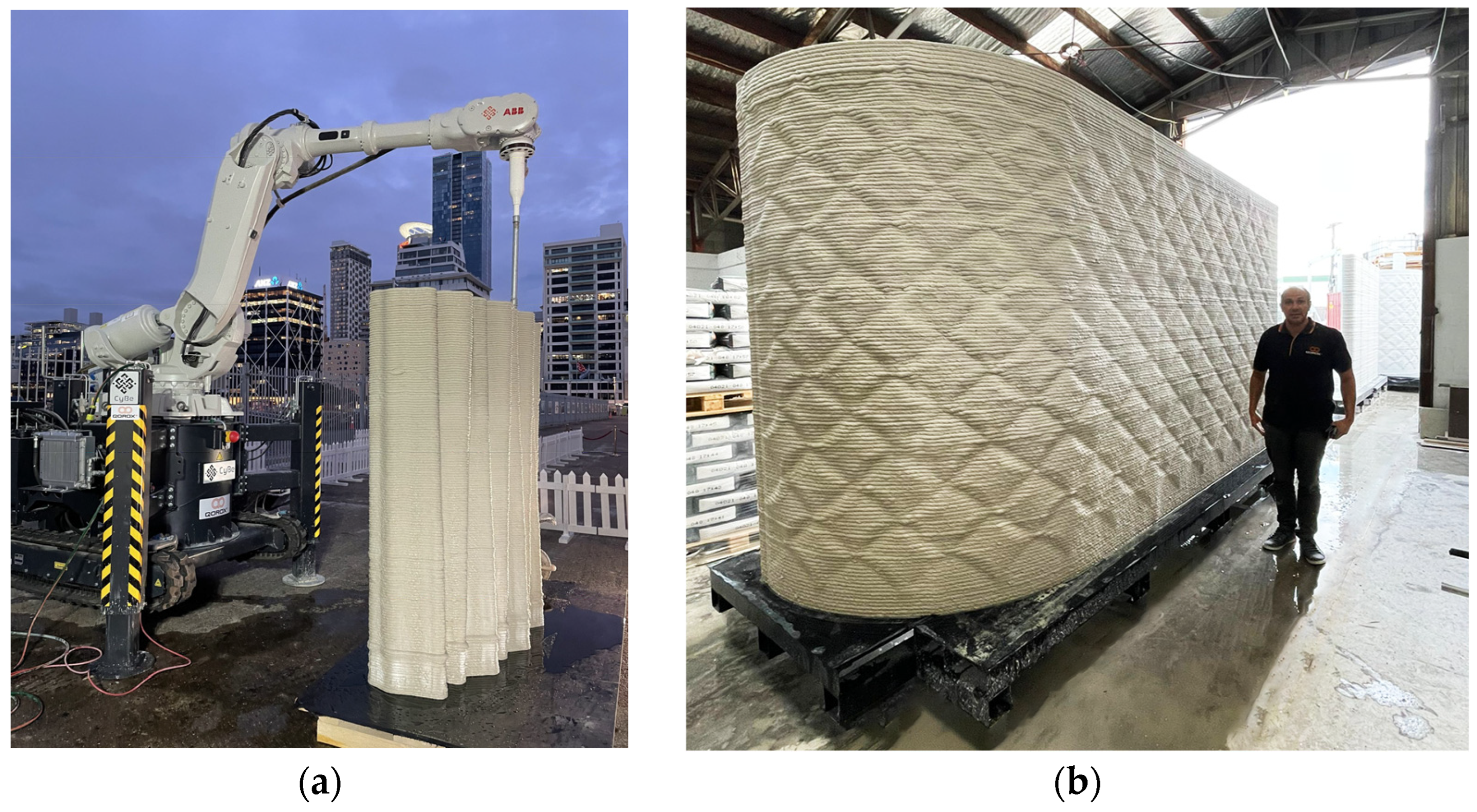
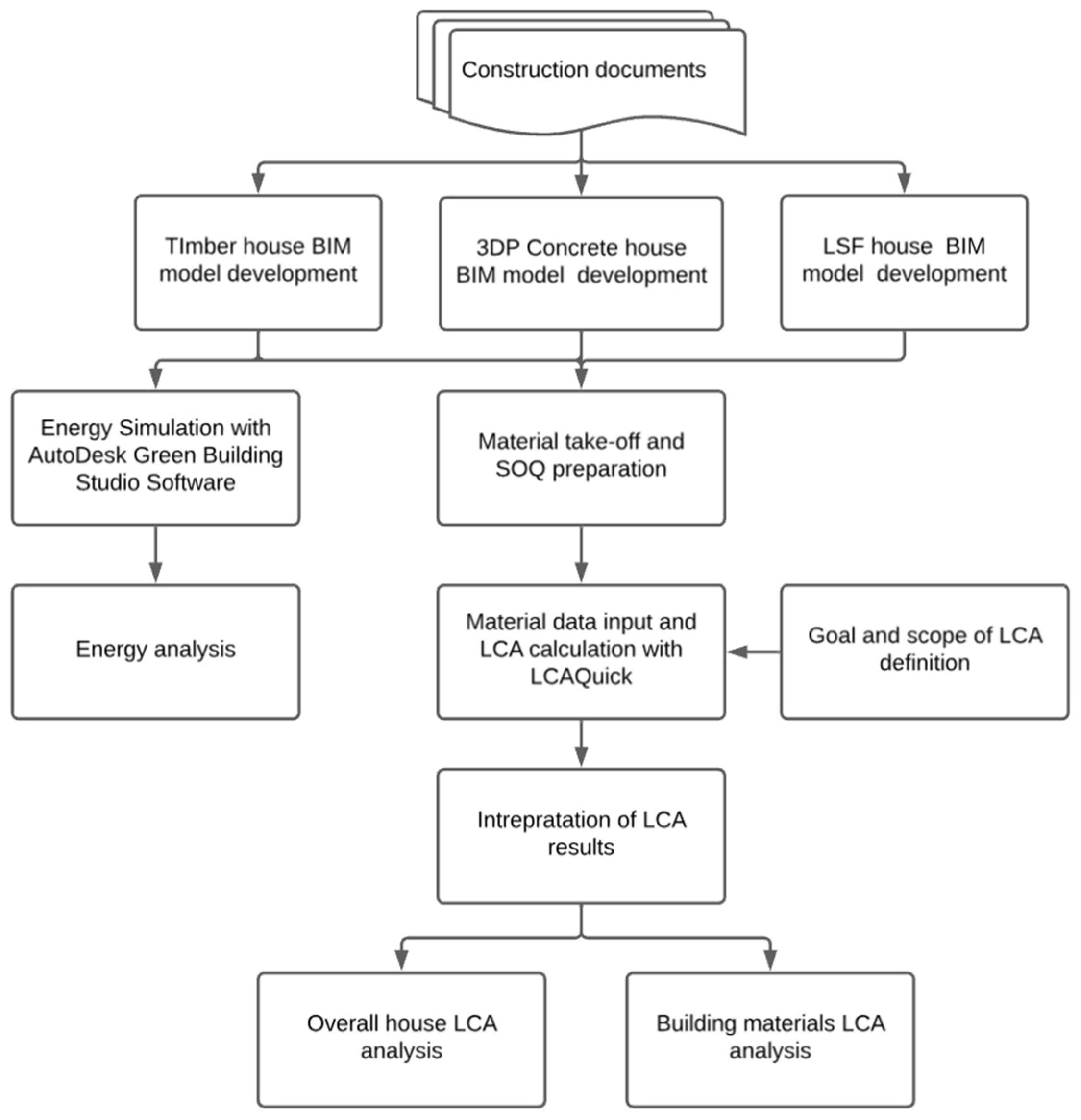
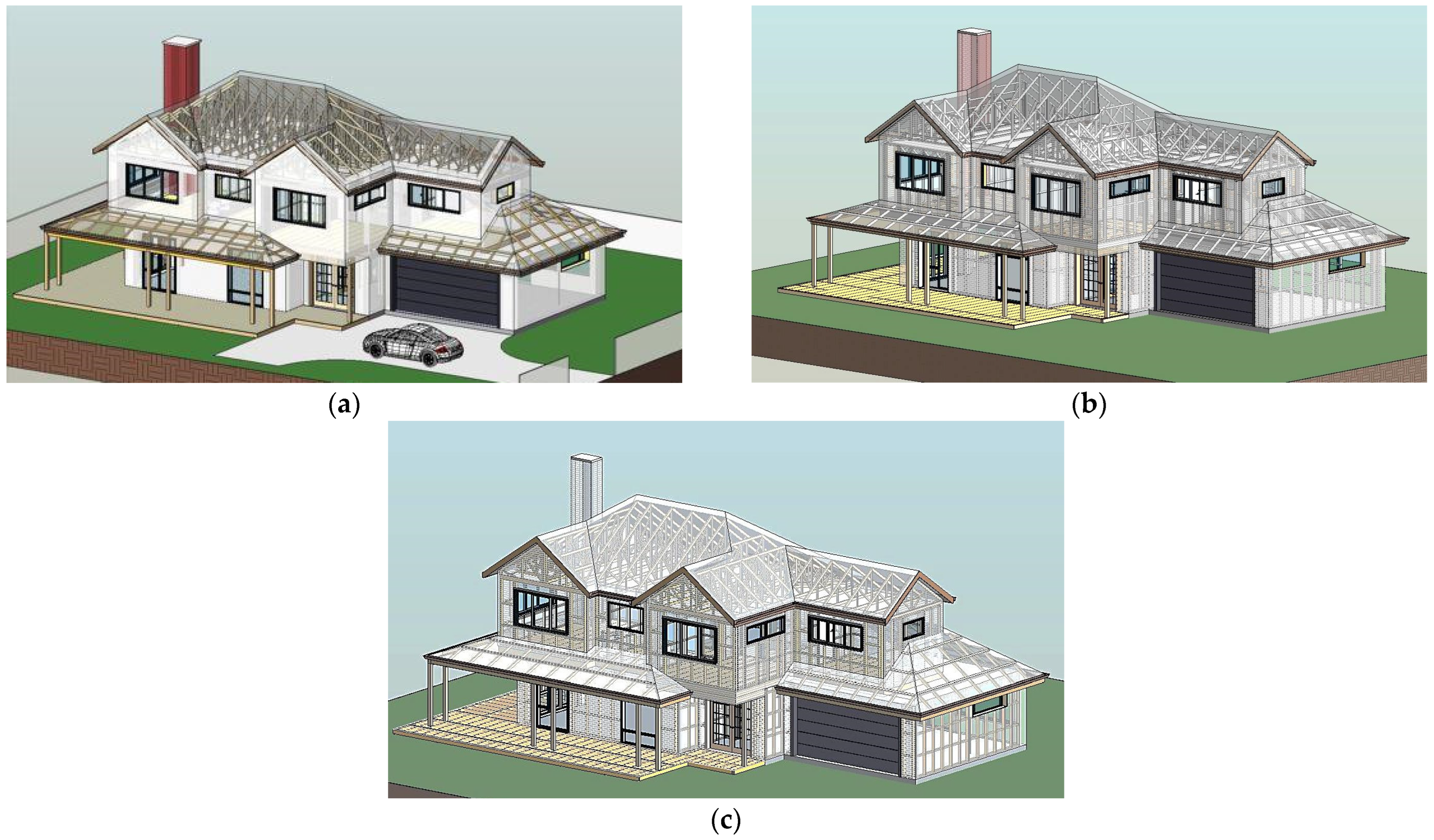
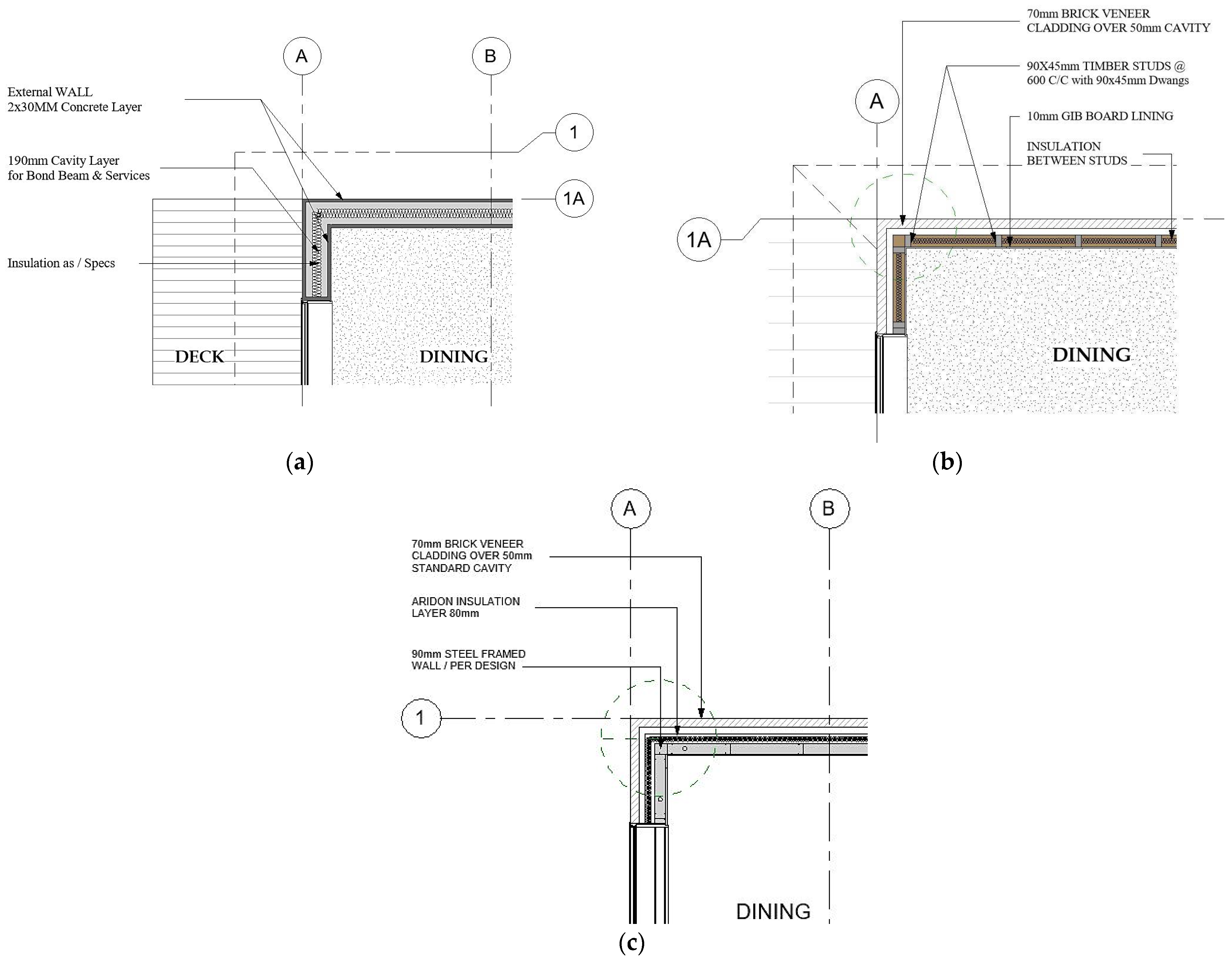
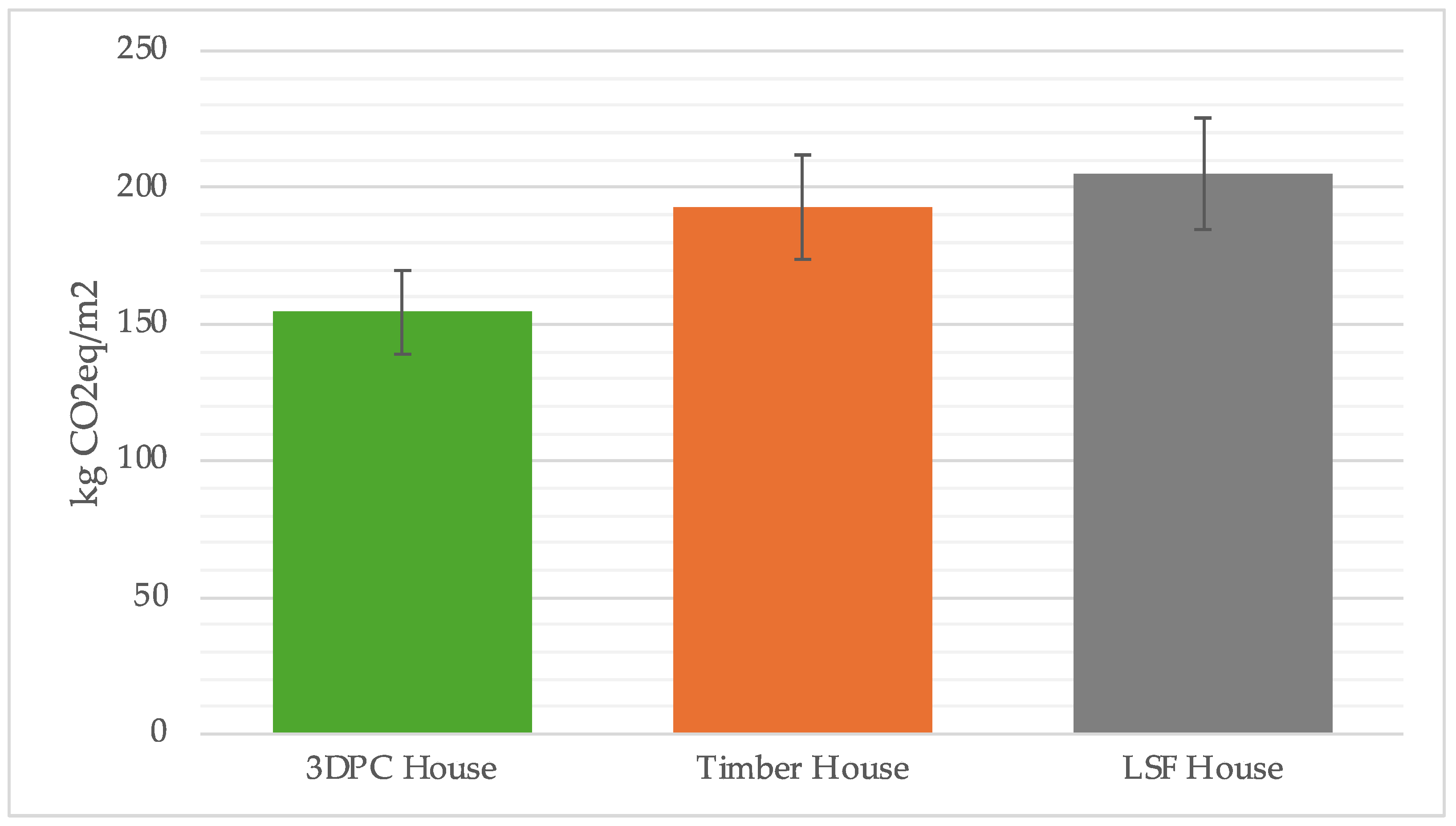




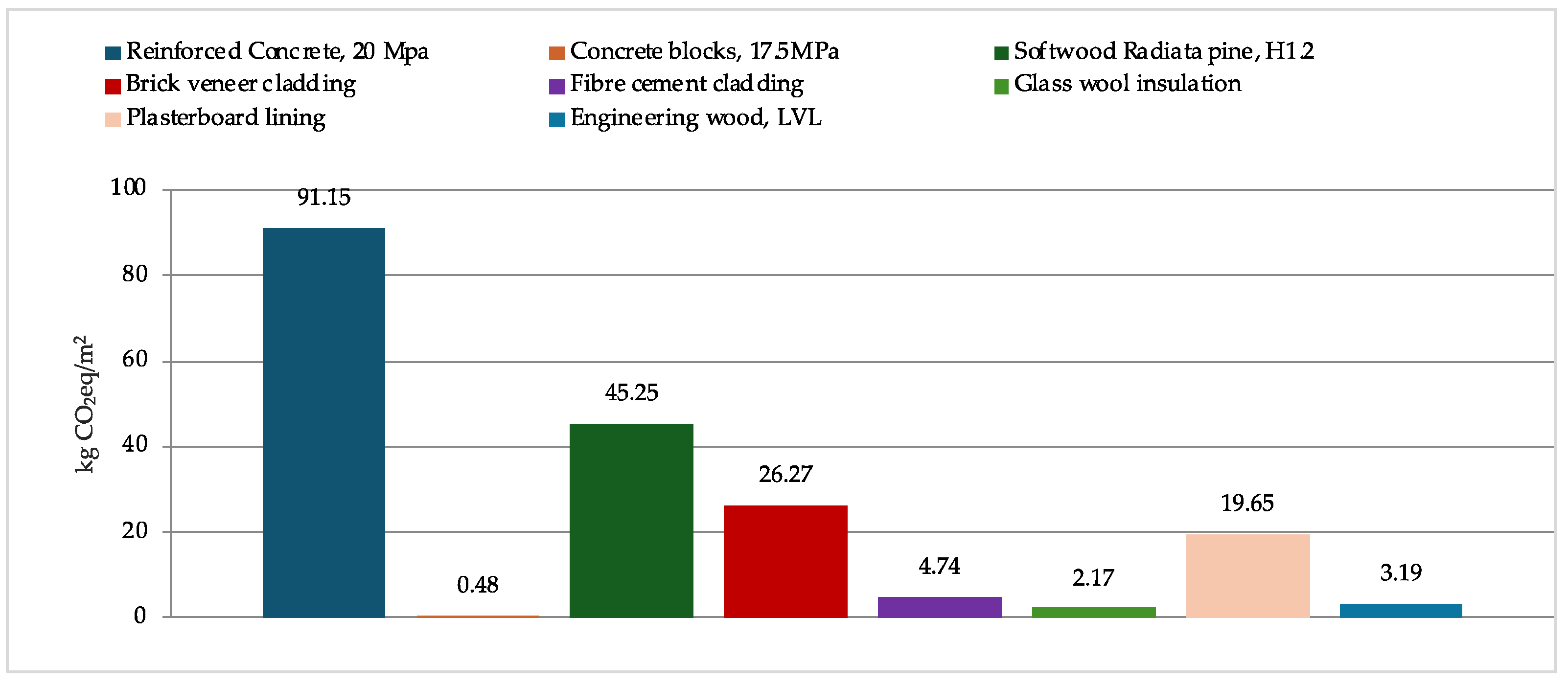
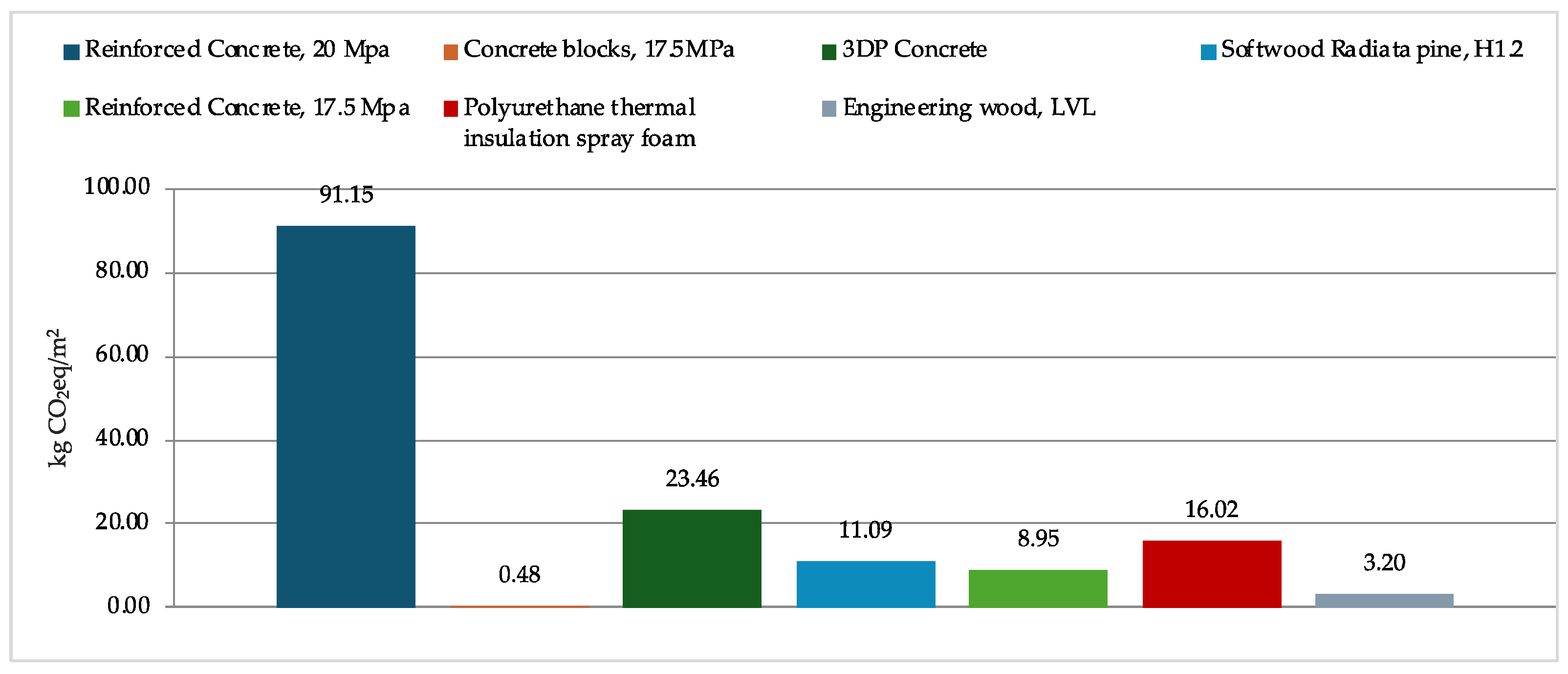
| Category | Information |
|---|---|
| Location | Orewa, Auckland, New Zealand |
| Wind zone | Very high |
| Climate zone | 1 |
| Main structural system | Light steel framed |
| Ground floor area | 133 m2 |
| First floor area | 92 m2 |
| Gross floor area (GFA) | 225 m2 |
| Height of wall framing ground floor/first floor | 2650 mm/2455 mm |
| Household occupancy | 2 people or couple |
| Categories | Elements | Material Quantity (m3) | Comments/Specifications | ||
|---|---|---|---|---|---|
| 3DPC House | LSF House | Timber House | |||
| Foundation | RibRaft concrete floor | 39.9 | 39.9 | 39.9 | 20 MPa Concrete |
| Wall system/assemblies | Concrete wall | 0.7 | 0.7 | 0.7 | 200 mm concrete masonry: cast in situ |
| Walls and structure | 23.682 | 13.426 | 19.66 |
| |
| 1.52 | - | - |
| ||
| Bond beam | 3.99 | - | - | 190 × 200 mm beam between the 30 mm concrete layers and vertical reinforced concrete. 17.5 MPa Concrete with reinforcement | |
| Brick cladding | - | 8.98 | 8.98 | 70 series brick veneer with 50 mm cavity, with stainless steel ties horizontally 600 mm | |
| Weatherboard cladding | - | 0.74 | 0.74 | 6 mm fibre cement weatherboard | |
| Insulation | 23.68 | 23.68 | 23.68 |
| |
| Lining | - | 7.62 | 9.88 | 10 mm standard plasterboard | |
| Sub-floor | Floor joists | 2.4 | 1.11 | 2.4 |
|
| Roof structure | 4.37 | 0.08 | 4.37 |
| |
| Additional structure | Mild steel structural members | - | 0.3 | - | PFC-Parallel Flange Channel, UB—Universal Beams & Steel Posts |
| Category | Information |
|---|---|
| Tool path length/3DP distance (D) | 2500 mm |
| Average speed of printing (V) | 500 mm/s |
| Height (H) | 1050 mm |
| Layer height | 15 mm |
| Layer width | 30 mm |
| Number of layers | 70 No.s |
| Time for one layer | 5 s |
| Time for total layers | 10.286 m2/h |
| Total surface area of the house | 263.13 |
| Total time for entire 3DP house | 25.58 h |
| Parameter | 3DPC House | Timber House | Difference |
|---|---|---|---|
| Annual energy cost ($/year) | 1527 | 2425 | 37% |
| Life cycle cost ($) | 20,793 | 33,029 | 37% |
| Annual electric energy consumed (kWh) | 4186 | 5157 | 19% |
| Annual CO2 emissions (SUV Equivalent) | 0.20 | 0.40 | 50% |
| Categories | Unit | 3DPC | Timber | LSF |
|---|---|---|---|---|
| Climate change (global warming) | kg CO2 eq | 154.35 | 192.89 | 204.89 |
| Ozone depletion (stratospheric ozone) | kg CFC 11 eq | 2.45 × 10−5 | 9.10 × 10−6 | 1.01 × 10−5 |
| Acidification for soil and water | kg SO2 eq | 9.38 × 10−1 | 9.98 × 10−1 | 1.86 |
| Eutrophication | kg PO43− eq | 2.32 × 10−1 | 1.67 × 10−1 | 3.35 × 10−1 |
| Photochemical ozone creation (tropospheric ozone) | kg C2H4 eq | 7.71 × 10−2 | 9.37 × 10−2 | 1.62 × 10−1 |
| Depletion of antibiotic resources—elements (non-fossil fuels) | kg Sb eq | 2.96 × 10−4 | 4.37 × 10−4 | 7.26 × 10−3 |
| Depletion of antibiotic resources (non-fossil fuels) | MJ (NCV) | 1.59 × 103 | 1.70 × 103 | 2.14 × 103 |
| Life Cycle Stages | Global Warming Potential (GWP) (kgCO2eq/m2) | ||
|---|---|---|---|
| 3DPC | Timber | LSF | |
| A1–A3: Product stage | 126.58 | 123.50 | 206.57 |
| A4–A5: Construction stage | 13.15 | 30.64 | 20.11 |
| B2: Maintenance and B4: Replacement | 0.00 | 0.00 | 0.00 |
| C1–C4: End-of-life | 20.01 | 49.63 | 17.92 |
| D: Benefits and loads beyond the system boundary | −5.40 | −10.88 | −39.71 |
| Total | 154.35 | 192.89 | 204.89 |
Disclaimer/Publisher’s Note: The statements, opinions and data contained in all publications are solely those of the individual author(s) and contributor(s) and not of MDPI and/or the editor(s). MDPI and/or the editor(s) disclaim responsibility for any injury to people or property resulting from any ideas, methods, instructions or products referred to in the content. |
© 2024 by the authors. Licensee MDPI, Basel, Switzerland. This article is an open access article distributed under the terms and conditions of the Creative Commons Attribution (CC BY) license (https://creativecommons.org/licenses/by/4.0/).
Share and Cite
Khan, M.; Dani, A.A.; Lim, J.B.P.; Roy, K. Appraising the Feasibility of 3D Printing Construction in New Zealand Housing. Buildings 2024, 14, 1084. https://doi.org/10.3390/buildings14041084
Khan M, Dani AA, Lim JBP, Roy K. Appraising the Feasibility of 3D Printing Construction in New Zealand Housing. Buildings. 2024; 14(4):1084. https://doi.org/10.3390/buildings14041084
Chicago/Turabian StyleKhan, Mohammad, Aflah Alamsah Dani, James B. P. Lim, and Krishanu Roy. 2024. "Appraising the Feasibility of 3D Printing Construction in New Zealand Housing" Buildings 14, no. 4: 1084. https://doi.org/10.3390/buildings14041084
APA StyleKhan, M., Dani, A. A., Lim, J. B. P., & Roy, K. (2024). Appraising the Feasibility of 3D Printing Construction in New Zealand Housing. Buildings, 14(4), 1084. https://doi.org/10.3390/buildings14041084








